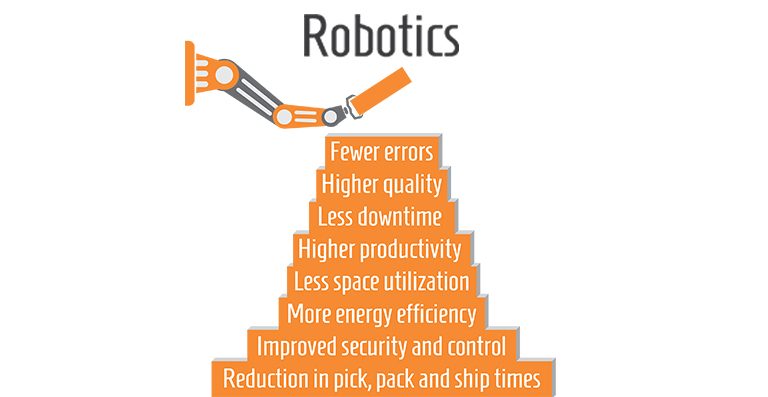The Advantages of Robotics in the Plastic Processing Industry
Robots have been around for years and making strides of progress for manufacturers in terms of speed, efficiency, and safety. In the last few years, many new findings on productivity and engineering innovations have made the use of robotics even more popular and made robots powerful partners at manufacturing facilities.
Cartesian or linear robots (beam robots) have been employed in the plastic industry for decades but now even six-axis robots are being used at a wide scale. The use of these robots has become quite widespread in China and the USA. As a result, the sale of robot sales to processors is at an all-time high.
Some of the major factors responsible for their increased popularity is reduced cost of ownership and how user-friendly these machines have become. Shop floor personnel can now easily set-up and program the robots. With lower costs, even small and mid-sized processors can leverage the automation wave and reap the benefits of the technology.
If you are considering introducing robotics to your processing facility, here are a few advantages that might help you with your decision:
Higher Productivity, Lower Expenses
Automation process has been a boon for the plastic processing sector as it offers numerous benefits including a boost in productivity, precision, increased flexibility, and cost savings. Robots can work non-stop while offering high precision. Many processors have even achieved 15-30% increase in productivity after adopting a robotic automation process!

What’s more, automation also leads to savings in raw materials. When it comes to carbon fiber composite materials, this factor becomes highly beneficial as raw material cost is extremely high. The use of robots also helps in saving labor costs and redirects manpower to positions where they can provide more value. The savings made on these costs directly affects the bottom line.
Outstanding Multi-Tasking Capabilities
As mentioned earlier, lineal robots have been used in the industry for most of the heavy lifting. Six-axis robots used to be relatively unpopular as they were regarded as expensive and complicated to operate. However, with innovations in technology, there has been a rise in collaborative robots that are easy to program.
When it comes to complicated molded parts, it isn’t possible to directly eject a part from the mold. However, six-axis robots can easily manage complicated molded parts by rotating and maneuvering the part out of the mold. In addition, the multi-tasking capabilities allows these robots to do two or more jobs at once. For example, while a part is being ejected from a mold, the machine can simultaneously perform additional work.
Six-axis robots offer many competitive advantages by reducing labor costs and replacing skilled operators. In fact, many factories in the US and Europe can now re-shore as these robots can save costs over what used to be considered cheap labor.
Increased Worker Safety
Robots offer numerous primary and secondary benefits to users. They can keep workers safe from hazardous conditions and complete the task at hand with ease. Consolidated Metco, an engineered components manufacturer, was able to automate part removal from an injection molding press using a large four-axis robot.
Such robots can handle such specific applications. They are also flexible enough to complete a broad range of part removal tasks and positioning requirements over the injection-molding machine’s life cycle. These robots satisfy all positioning requirements and can replace a worker who would have to maneuver between moving parts.

The implementation of robotics in the plastic processing industry has reduced cycle times, standardized part quality, reduced costs, and much more. It also helps in ensuring worker safety by taking over potentially dangerous tasks. If you’re interested in robotics for plastic processing, make sure to visit Plastivision India 2020 where there will be live demonstration from manufacturers.
Leave a Reply Cancel reply
Recent Posts
- Understanding The Materials That Are Used To Build Plastic Toys
- All You Need To Know About Food-grade Plastics
- A Glance At The Materials That Boost The Performance Of Plastics
- Understanding The Importance Of Exploring New Business Opportunities In The Plastic Industry
- Understanding The Importance Of Investing in R&D For The Plastic Industry
Categories
- 3D Printing
- AIPMA
- Automation
- Automobile Sector
- Bio Plastics
- Environment
- Innovations In Recycling
- Latest Innovations
- Molds & Dies
- News
- Packaging Industry
- Plastic
- Plastic Application
- Plastic Industry
- Plastic Market
- Plastic Myths
- Plastic News From The World
- Plastic Packaging
- Plastic Products
- Plastic Recycling
- Plastic Solar Cells
- Plastic Toys
- Plastic Waste
- Plastic World
- Plastics
- Plastics And Their Applications
- Plastics In Agriculture
- Plastics In Healthcare
- Plastics In Medical Industry
- Plasticulture
- Processing Machinery
- Recycling Machines
- Robotics
- Uncategorized
- Virtual Reality
Archives
- November 2023 (3)
- October 2023 (2)
- September 2023 (3)
- August 2023 (3)
- July 2023 (3)
- June 2023 (3)
- May 2023 (2)
- April 2023 (2)
- March 2023 (2)
- February 2023 (2)
- January 2023 (2)
- December 2022 (3)
- November 2022 (1)
- October 2022 (1)
- September 2022 (2)
- August 2022 (1)
- July 2022 (3)
- May 2022 (3)
- March 2022 (2)
- February 2022 (1)
- January 2022 (1)
- September 2021 (2)
- August 2021 (3)
- July 2021 (4)
- June 2021 (4)
- May 2021 (3)
- April 2021 (2)
- March 2021 (4)
- November 2019 (8)
- October 2019 (8)
- September 2019 (8)
- August 2019 (8)
- July 2019 (8)
- June 2019 (8)
- May 2019 (8)
- April 2019 (8)
- March 2019 (8)
- February 2019 (11)
- January 2019 (8)
- December 2018 (8)
- November 2018 (12)
- October 2018 (12)

